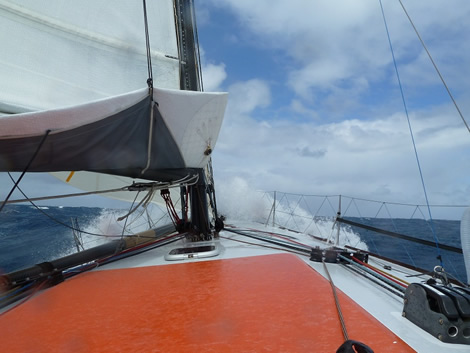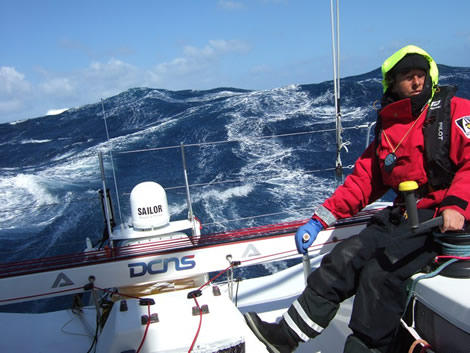Force 9 battering
With a low pressure system sweeping eastwards below Global Ocean Race Class40s, many boats have switched to survival mode as a Force 9 gale blasts squalls and intensely strong south-westerly wind through the fleet’s narrow corridor between 42°S and 45°S in the Indian Ocean’s Roaring Forties.
Furthest north in fifth place, the autopilot on Phesheya-Racing has been unable to cope with 45 knot squalls, forcing Nick Leggatt and Phillippa Hutton-Squire to hand steer and reduce sail. On Financial Crisis, Marco Nannini and Hugo Ramon in fourth, sailing 70 miles further south than Leggatt and Hutton-Squire, recorded 52.7 knots of wind, but continued to average 11-12 knots throughout Friday night and Saturday morning, taking refuge down below as the storm raged.
On Campagne de France, 1,000 miles directly north of the storm’s centre, and 558 miles east of Financial Crisis, Halvard Mabire and Miranda Merron also registered 52 knots and steep waves with hail stones strafing the Franco-British duo. At the front of the fleet, Conrad Colman and Sam Goodchild set a new GOR 24-hour run record of 350 miles on Friday morning with Cessna Citation and continued to poll the fleet’s highest averages on Friday night and into Saturday, extending their lead over Ross and Campbell Field in second with BSL despite the father-and-son duo averaging just under 13 knots for most of Saturday.
Early on Saturday morning, the South Africans were over-canvassed on Phesheya-Racing: “We made a mistake today,” admits Phillippa Hutton-Squire. “I saw the wind increasing quite quickly from 25-30-32-34-36 knots and suddenly the big black cloud that had been approaching us for a while was overhead and it was blowing 45 knots,” she reports. “The autopilot could not handle it and it spun out, the sails were flapping and there was water flying everywhere.” Hutton-Squire quickly grabbed the helm, taking the Akilaria Class40 downwind while Nick Leggatt put in a third reef.
Since the drama, Phesheya-Racing has been averaging between nine and ten knots and the South Africans are trying to keep it safe: “It’s a fine balance between keeping yourselves and the boat together and achieving good speeds,” Hutton-Squire points out. “We’re not out here for only 24 hours; we have been at sea for two and-a-half weeks and have another three or so to go before we reach Wellington,” she explains. “So, we can’t push ourselves right to the limit for 24 hours because the next 24 hours we’ll have to recuperate, but the boat will keep sailing along - it’s all about finding the right balance for you and your boat. Just like most things in life, you should never bite off more than you can chew!”
Ahead of Phesheya-Racing by 232 miles on Saturday afternoon, Marco Nannini and Hugo Ramon are suffering surf-fatigue on Financial Crisis: “Even the novelty of riding the back of a Southern Ocean low wears out after a while,” commented Nannini on Saturday morning. “It’s amazing what you get used to,” he adds. Nannini and Ramon report maximum wind of 52.7 knots, but withstanding a constant 33-48 knots has becoming standard practice for the Italian-Spanish duo. “We’ve been below, hatch closed, for the past two days pretty much eating and sleeping and riding this mad highway averaging around 12 knots but with surfs well above 20 knots,” Nannini continues. “Unfortunately, with such a wide range we can’t really put any more sail up as we have to be careful about the top end and the gusts, so we are a little slower when the wind drops – it’s up and down all the time.” Although the sail plan may be less than the duo would like, Financial Crisis was averaging the highest speed in the fleet at 11.7 knots at 15:00 GMT on Saturday.
With the sustained surfs, there has been gear failure on board: “Bad news is we have broken the Watt & Sea hydrogenerator,” confirms Nannini. Fitted on the transom with a system similar to an outboard engine mounting, the unit is lowered into the water to charge the yacht’s batteries. “The bracket that holds it always looked flimsy to me and today the whole thing just buckled and bent and now we can’t hold the propeller in the water,” he explains. “I will have a better look when conditions permit, but I suspect we’ll have to rely entirely on the little diesel we have left to charge our batteries.” Nannini and Ramon will have to economise on power-usage and sacrifice some vital comfort. “We’ll be cutting down on electricity consumption and forgetting the lovely heater that had made such a difference in the worst moments of the upwind storm a couple of days back,” regrets the Italian skipper.
Meanwhile, on Friday night, 60 miles north of the GOR’s Australian Ice Limit, Halvard Mabire and Miranda Merron were charging through the Southern Ocean with the headlights off: “Full concentration for downwind surfing after dark with the wind occasionally touching 32-33 knots and the sea state building quite quickly,” reported a breathless Miranda Merron early on Saturday morning. “I can only tell the sea state when the sky clears from time to time and the stars nearer the horizon are obliterated by the wall of water in front.” With the wind building quickly to 40 knots, it was time for action: “Time to take the third reef and furl the Solent,” reports Merron. “By the time that manoeuvre is complete, the wind has hit 52 knots, and Campagne de France is being lashed by a squall - it’s really cold.”
At 22:00 GMT on Friday night, the speed averages began to drop below ten knots and at daybreak in the Eastern Indian Ocean, one hour later, averages were down to between eight and nine knots. “The wind never dropped below 35 knots after that and the Dantesque sea state was revealed at dawn,” says Merron. “Sometimes it would be best not to know as there were huge waves, very disordered and very steep, some of them breaking heavily.” With no regular wave train, picking a route through the mêlée was near-impossible. “It’s hard to know how to place the boat and we are now on survival sailing, not racing,” she admits. “Every squall has produced 48-50 knots and sometimes hail as well, leaving ice all over the cockpit floor.”
By 15:00 GMT on Saturday, Campagne de France was averaging 11.3 knots and conditions had been improving for Mabire and Merron. “As the day has gone on, the sea state has improved a little, as in the waves are better aligned, but still towering behind the boat, and dropping off steeply under the bow - you could ski down these ones! The Indian Ocean is really living up to its reputation.”
Meanwhile, 487 miles east of Campagne de France, Colman and Goodchild had been averaging 13-14 knots overnight with Cessna Citation, skimming five miles above the Australian Ice Limit at 45°S. At 15:00 GMT on Saturday, their speed had dropped to 11 knots and Ross and Campbell Field slowed to just over ten knots on BSL with Colman and Goodchild adding an impressive 42 miles to their lead in 24 hours. Leading BSL by 113 miles on Saturday afternoon, Conrad Colman had important, geographical matters on his mind: “So, we passed Cape Leeuwin today and I couldn't care less,” states the 27 year-old Kiwi. “Don't get me wrong, I know that in conventional wisdom Leeuwin marks the point where the Indian Ocean becomes the South Pacific Ocean and for this reason I'm thrilled that we've ‘knocked the bastard off’ to use Sir Edmund Hillary's tasteful comment from when he climbed Everest.”
However, Colman believes the cape’s status is overplayed: “Firstly, geographically, it’s a pip squeak, an embarrassingly small protrusion that lowers the level for capes internationally,” he states. “Secondly, it’s neither the most southerly point nor the most westerly point in Australia, so it’s completely irrelevant,” adds Colman, warming to the theme. “Finally, as a Kiwi, I can't let anything that’s Australian be celebrated undeservingly, so I hereby propose that the three Great Capes now be the Cape of Good Hope; South Cape on the bottom of Stewart Island and, of course, Cape Horn,” he submits. “South Cape makes so much more sense in every way as it is part of New Zealand - so automatically it’s a winner – and beyond this, geographically it makes more sense as the divider of the oceans because it’s further south and it’s easier to find on a chart!”
Leaderboard at 15:00 GMT:
1. Cessna Citation: DTF 2,461 11kts
2. BSL: DTL 113 10.1kts
3. Campagne de France: DTL 487 11.3kts
4. Financial Crisis: DTL 1045 11.7kts
5. Phesheya-Racing: DTL 1277 8.9kts












Latest Comments
Add a comment - Members log in